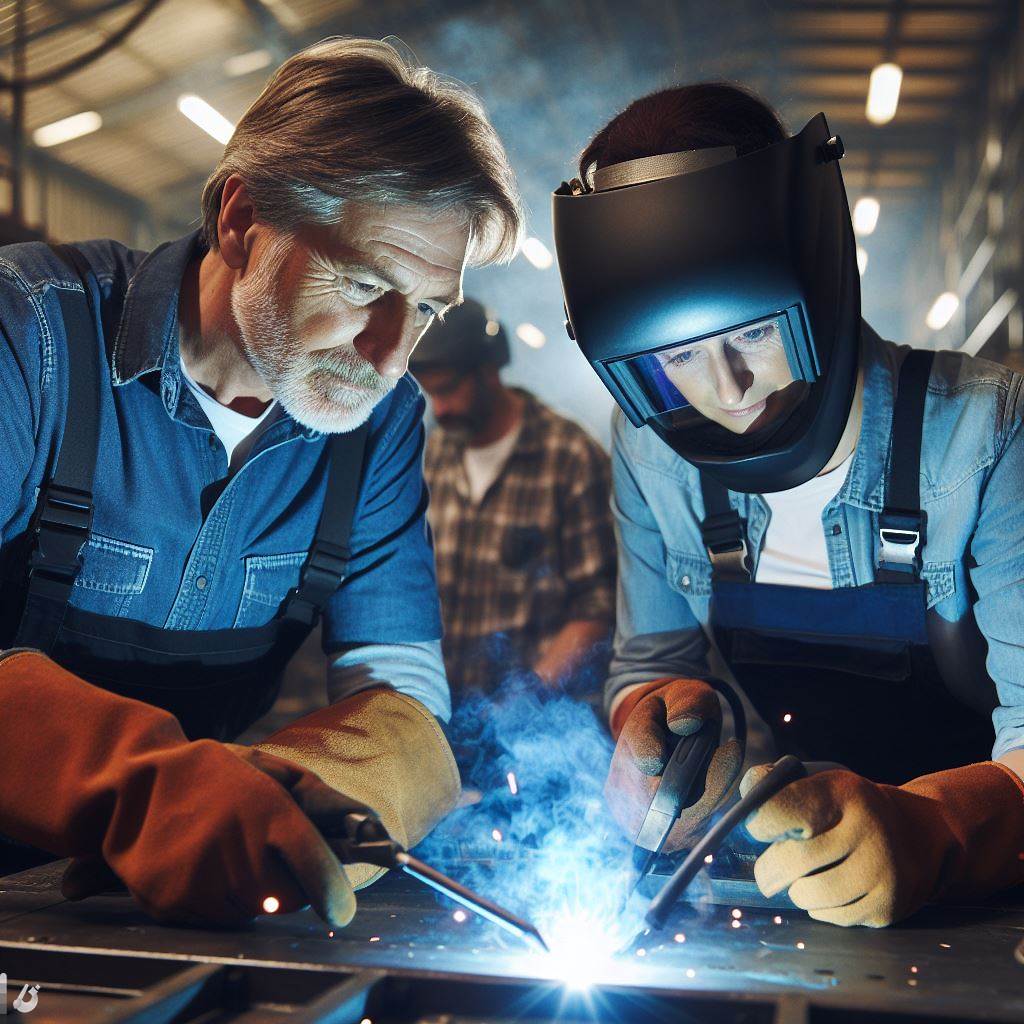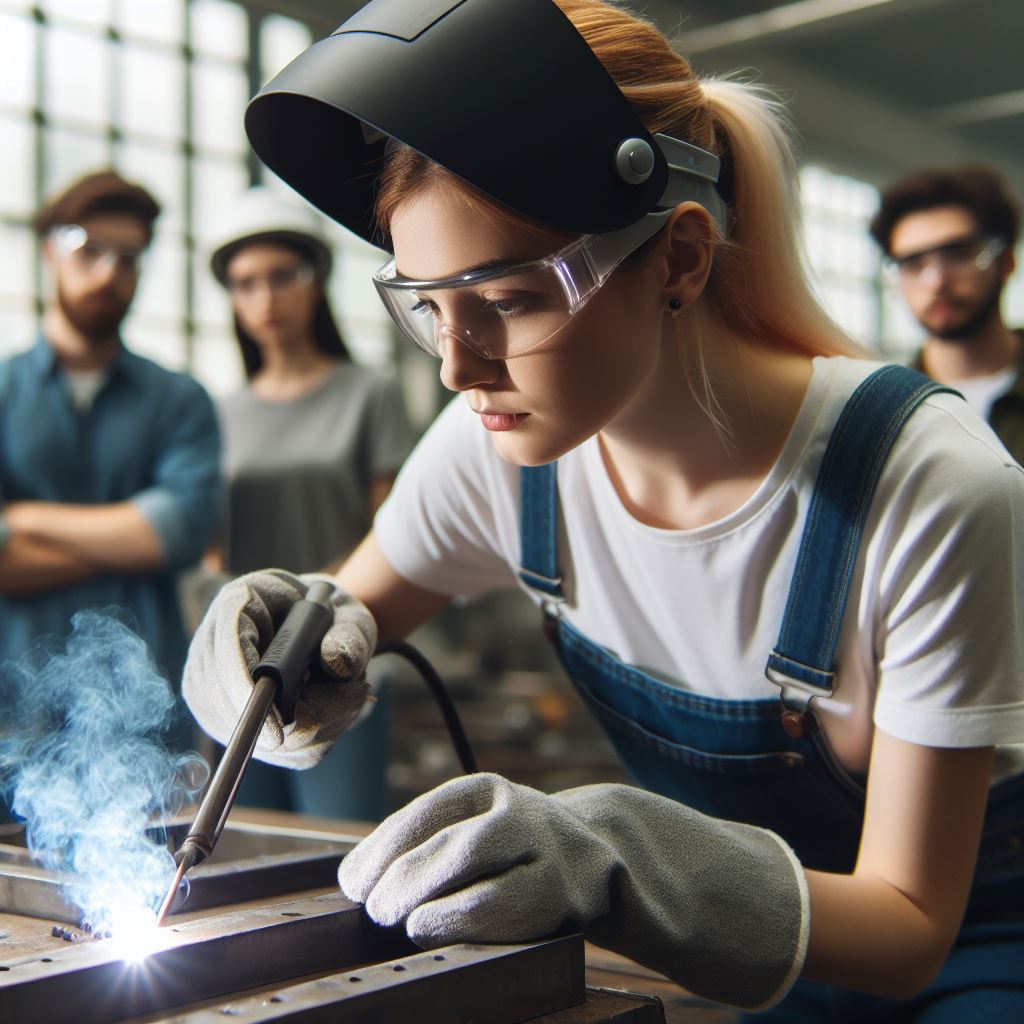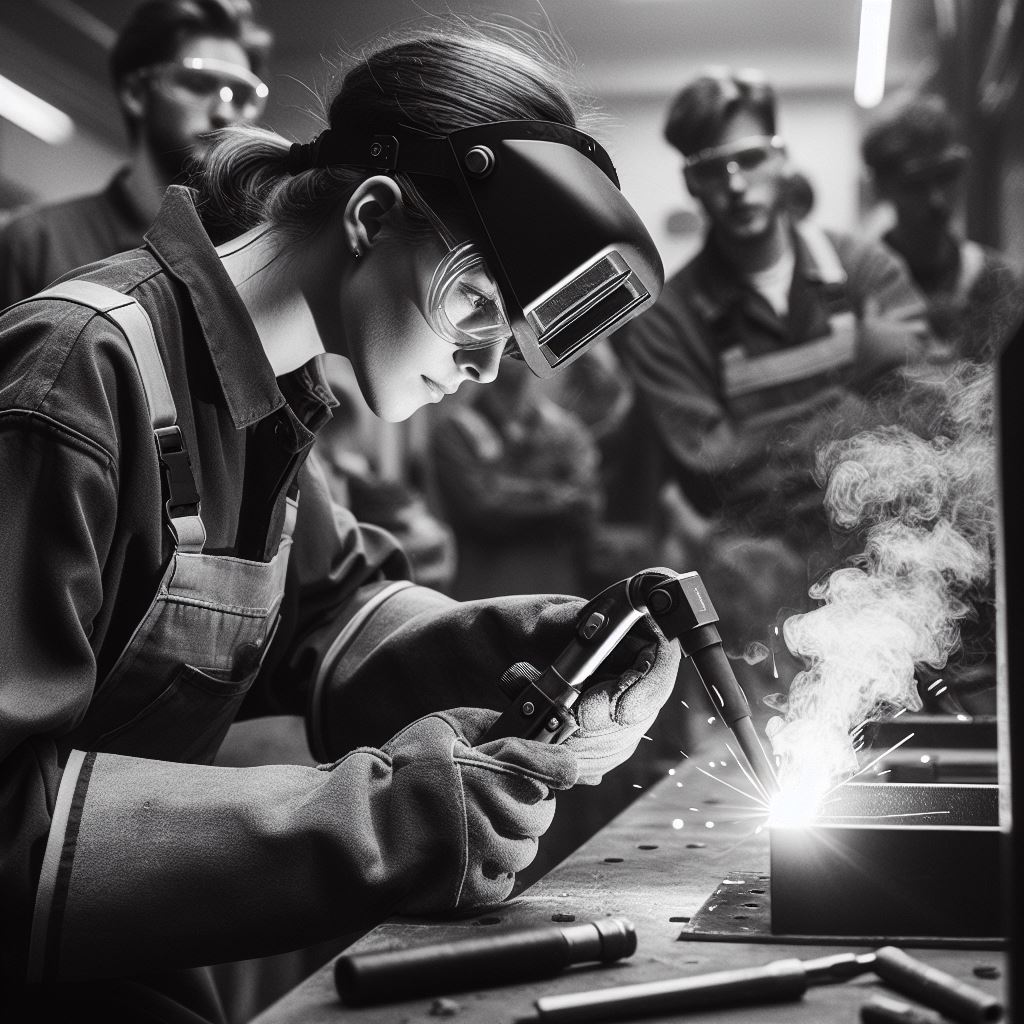Introduction
Discover the dynamic world of welding in the UK with our guide to the “Top 10 Welding Projects.”
Welding plays a pivotal role across industries, showcasing its significance in construction, automotive, and artistic pursuits.
From structural welding to custom metal artwork, the diversity of projects reflects the versatility of this craft.
As we delve into the top projects, you’ll witness the fusion of creativity and precision that defines British welding.
Whether it’s crafting robust steel structures or adding intricate metal details to architectural designs, these projects exemplify the artistry and practicality inherent in welding.
Join us on this journey as we explore the popularity and impact of welding projects that shape the landscape of industries throughout the United Kingdom.
Welded Metal Art
Welding’s rising popularity in the UK extends to crafting unique metal artwork, favored by artists and enthusiasts for its versatility and durability.
Welded sculptures, depicting animals, humans, or abstract shapes, showcase three-dimensional creativity indoors and outdoors.
Welded wall hangings, featuring intricate designs from geometric patterns to nature-inspired motifs, elevate interior décor with various metals like steel, copper, or brass.
Renowned metal artists like Anthony Gormley and Anish Kapoor, known for iconic works like the Angel of the North, inspire a new wave of artists like Sarah Sze.
Up-and-coming artists like Sarah Sze blend everyday objects with welded metal, exhibited globally, reflecting the growing influence of this art form.
The trend signifies welding’s transformative power, allowing artists to defy traditional limits, creating extraordinary pieces from small sculptures to large installations.
The enduring appeal of welded metal art in the UK is evident in the work of established and emerging artists alike.
In general, the surge in welding for metal artwork in the UK highlights the enduring creativity of this form, from sculptures to wall hangings.
Renowned and emerging artists, inspired by the likes of Gormley and Kapoor, continue to push the boundaries, ensuring welded metal art’s lasting presence in the UK art scene.
Personalized UK Career Consulting
Receive tailored career guidance designed just for you. Get actionable steps and expert support to boost your career in 1-3 days. Take control of your career now.
Get StartedRead: Day in the Life of a London Plumber
Automotive Welding
Welding is pivotal in the automotive industry, guaranteeing vehicle strength and durability in manufacturing and repair, particularly in joining body panels.
Precision is critical, demanding accuracy in aligning panels and welding intricate parts for a flawless finish.
Safety is paramount due to high temperatures and potential exposure to harmful fumes; welders must follow strict safety protocols and wear appropriate protective gear.
Automotive welding expertise spans techniques like MIG, TIG, and resistance spot welding, catering to various applications.
MIG welding’s versatility suits automotive needs; TIG welding excels in precision and aesthetic appeal for custom car fabrication.
Resistance spot welding is prevalent in mass car production, ensuring rapid and efficient welding of sheet metal parts.
Welding in car manufacturing involves assembling chassis, frames, and suspension components, necessitating strong and reliable welds for vehicle and occupant safety.
Engines and exhaust systems benefit from welding, ensuring proper sealing and performance.
Automotive welding extends to roll cage fabrication, enhancing safety in racing and off-road vehicles.
Advanced technologies like laser welding and robotic welding improve efficiency and precision in automotive welding.
Robotic welding systems, widely used in large-scale manufacturing, enhance productivity and reduce human error.
Quality control in automotive welding involves rigorous testing and inspection, including non-destructive methods like x-ray and ultrasonic inspection.
High standards in automotive welding contribute to overall vehicle quality and reliability, sustaining demand for skilled welders in the industry.
Your Dream Job Starts with a Perfect CV
Get a tailored CV and cover letter that captures your unique strengths and stands out in your industry. Let us help you make an unforgettable first impression.
Get StartedRead: Top Plumbing Schools in the UK Reviewed
Construction and Infrastructure
Welding is crucial in the UK’s construction and infrastructure sectors, demanded for modern, robust structures. Professionals in these fields necessitate welding skills.
Bridges, engineering marvels connecting communities, rely on welding for construction. Steel, prized for strength, undergoes seamless fusion, ensuring structural integrity against heavy loads and harsh weather.
Similarly, buildings, from skyscrapers to residential complexes, depend on welding. Welders join beams, columns, and metal frames, ensuring stability using techniques like arc welding and GMAW.
Pipelines, vital for fluid transportation, require welding for leak-free joints. Various techniques like SMAW and FCAW are employed based on material and joint strength, maintaining strict quality standards.
Different weld types serve specific purposes in construction. Butt welds join materials along edges, common in beams and columns.
Fillet welds, triangular, connect surfaces at angles, prevalent in bridges. Lap, corner, and plug welds have specific applications based on structural requirements.
In review, welding’s vital role in the UK’s construction and infrastructure sectors is evident in bridges, buildings, and pipelines.
Welding techniques accommodate diverse construction needs, and understanding weld types is crucial for secure joints. Welding remains indispensable amid the UK’s growing demand for robust structures.
Read: Health & Safety in UK Mechanics Workshops
Industrial Welding Applications
Industrial welding plays a crucial role in various industries, including manufacturing, oil and gas, and aerospace.
It involves a wide range of projects that contribute to the creation and maintenance of metal structures and components.
Here, we will explore the importance of welding in these industries and provide examples of specific welding projects in the UK.
Importance of Welding in Joining and Fabricating Metal Components
Welding serves as a fundamental process for joining and fabricating metal components in industrial applications.
Optimize Your LinkedIn for Success
Boost your LinkedIn profile with a professional bio, keyword-rich headline, and strategic recommendations that attract recruiters. Stand out from the crowd and get noticed.
Optimize NowIt allows for the creation of strong and durable connections, enhancing the structural integrity of the assembled parts.
By utilizing heat and pressure, welding melts and fuses the base metals, resulting in a unified whole that can withstand various stresses and forces.
In manufacturing industries, welding is crucial in producing large-scale metal structures such as bridges, buildings, and machinery.
The integrity and reliability of these structures heavily rely on the quality of welding that joins their different elements together.
Welding also helps in fabricating smaller components like brackets, frames, and gears, ensuring they are strong enough to endure the demands imposed on them.
Similarly, the oil and gas industry extensively utilizes welding for constructing pipelines, storage tanks, and drilling equipment.
These projects require welds capable of withstanding extreme pressure, temperature, and corrosive environments.
Through specialized welding techniques and appropriate material selection, welders in this sector contribute to the safe and efficient extraction, transportation, and storage of oil and gas resources.
Aerospace is another industry where welding plays a critical role. Aircraft and spacecraft demand lightweight yet strong structures.
Welding helps in fabricating components like fuselages, wings, and engine parts, ensuring their integrity while keeping weight to a minimum.
The aerospace sector also relies on precise welding techniques to join delicate and complex systems, including avionics and fuel systems.
Specific Industrial Welding Projects in the UK
- Manufacturing: Skilled welders are pivotal in constructing large steel structures, like the Shard in London; they ensure proper fusion for stability and safety.
- Oil and Gas: In pipeline projects, such as the Forties Pipeline System in the North Sea, welders guarantee weld integrity for efficient oil and gas transportation.
- Aerospace: Welding is vital in UK jet engine assembly; Rolls-Royce employs advanced techniques for components enduring extreme temperatures and stress.
- Automotive: Car manufacturing relies extensively on welding; welders contribute to structural integrity and safety, meeting strict quality standards for vehicles.
- Renewable Energy: Skilled welders play a central role in wind turbine production; they ensure precise fabrication, contributing to the UK’s renewable energy industry.
- Shipbuilding: The welding industry crucially constructs ship hulls and decks; welders join steel plates, forming watertight and durable vessels for the marine environment.
- Railways: Essential in railway track construction and maintenance, welding, especially Continuous Welded Rail (CWR), enhances stability and reduces maintenance needs.
- Defense: Welding is vital in defense industry fabrication; welders contribute to the strength of military vehicles, armor, and infrastructure, ensuring personnel and equipment safety.
- Chemical Processing: Welding is vital in constructing chemical processing plants; welders join pipes, tanks, and reactors for the safe containment and transport of hazardous substances.
- Power Generation: Essential in power plant assembly, welding contributes to boilers, heat exchangers, and turbines; skilled welders ensure efficient and reliable electricity generation in the UK.
Generally, welding’s diverse applications in manufacturing, oil and gas, and aerospace showcase its crucial role in creating structures and systems withstanding various conditions.
The examples emphasize skilled welders’ significance in specific UK industrial projects, underscoring their expertise and contributions.
Read: Average Salaries for Plumbers in the UK
Welding in the Renewable Energy Sector
The renewable energy sector has witnessed a significant surge in demand for welding services in recent years.
As the world shifts towards sustainable energy sources, the need for skilled welders has grown exponentially.
Here, we will explore the increasing demand for welding in the renewable energy sector, along with specific welding projects related to wind turbines, solar panels, and hydropower plants.
Additionally, we will discuss the sustainable impact of these welding projects in the renewable energy industry.
Increasing Demand for Welding in the Renewable Energy Sector
The shift towards renewable energy sources such as wind, solar, and hydropower has led to a rapid expansion of infrastructure development in these areas.
As a result, there has been a surge in the need for welding services. Welders play a crucial role in the construction, maintenance, and repair of various components in renewable energy projects.
Benefits of Welding in the Renewable Energy Sector
- Ensures structural integrity: Welding helps maintain the structural integrity of key components, ensuring their longevity and reliability.
- Promotes safety: Proper welding techniques ensure the safety of equipment and personnel by minimizing the risk of structural failure.
- Enhances energy efficiency: Welding plays a vital role in improving the energy efficiency of renewable energy infrastructure, reducing overall energy waste.
- Facilitates innovation: Welding techniques have evolved to cater to the unique requirements of renewable energy projects, enabling continuous innovation in the sector.
Welding Projects in the Renewable Energy Sector
The renewable energy sector offers a wide array of welding projects, ranging from the manufacturing of components to installation and maintenance.
Let’s explore some of the most common welding projects in this sector:
- Wind Turbines: Welders are involved in the fabrication of tower structures, nacelles, and turbine blades for wind energy projects. They ensure the precise assembly of components to withstand harsh weather conditions.
- Solar Panels: Welding is used in the construction of solar panel frames and supports. This ensures the durability and stability of the panels, allowing them to withstand environmental factors.
- Hydropower Plants: Welders are responsible for joining large sections of penstocks, which are used to carry water from the reservoir to the turbine. These welds must be strong and leak-proof.
- Energy Storage Systems: Welding is vital in creating storage tanks and containers used in energy storage systems, such as batteries and compressed air tanks.
- Subsea Welding: In offshore renewable energy projects, welders perform underwater welding to maintain and repair subsea structures like foundations and cables.
Sustainable Impact of Welding Projects in Renewable Energy
Welding projects in the renewable energy sector have a significant sustainable impact. Some key points to consider are:
- Reduced Carbon Footprint: By enabling the production of clean energy infrastructure, welding contributes to the reduction of greenhouse gas emissions.
- Long-Term Durability: Properly welded components have a longer lifespan, reducing the need for frequent replacements and consequently minimizing waste.
- Efficient Resource Utilization: Welding aids in the efficient use of materials by ensuring precise assembly and minimizing material wastage.
- Promotion of Renewable Energy: By supporting the construction and maintenance of renewable energy projects, welding plays a crucial role in promoting the adoption of sustainable energy sources.
Essentially, the demand for welding in the renewable energy sector is rising due to the growth of sustainable energy sources.
Welders play a vital role in various projects, from wind turbines to solar panels and hydropower plants.
These welding projects have a sustainable impact, reducing carbon emissions, promoting resource efficiency, and contributing to the long-term durability of renewable energy infrastructure.
As the world continues to prioritize sustainable energy, the importance of welding in this sector will only increase.

Custom Furniture and Design
Welding transcends utility, impacting custom furniture design, revolutionizing creation with visually appealing, durable pieces that leave lasting impressions.
Metal frames in chairs and tables, combining metal and wood, offer an industrial yet sophisticated touch, providing design versatility.
Welding effortlessly achieves intricate shapes and patterns, unlocking endless design possibilities for geometric sculptures and unique chair designs.
Welded furniture, visually appealing and highly durable, surpasses traditional alternatives, ensuring longevity and sturdiness even with heavy use.
Custom welded furniture allows tailored designs, collaborating with clients to meet specific needs, incorporating personalized details, and fulfilling exact requirements.
Welding facilitates upcycling old materials, creating environmentally friendly designs by repurposing scrap metal or salvaging materials from abandoned structures.
Welded furniture doubles as art, blurring boundaries between functional pieces and sculptures, transforming spaces into gallery-like environments.
The aesthetic appeal of welded furniture, with clean lines and precise welds, complements various interior styles, adding contemporary elegance effortlessly.
In essence, welding’s versatility, durability, and aesthetic appeal make it pivotal in crafting custom furniture designs that leave lasting impressions.
Welding in Metalworking and Sculpture
Welding, a versatile technique, revolutionizes metalworking and sculpture by enabling creativity, expression, and the fabrication of intricate structures.
It fuses metal pieces, crucial in creating iconic sculptures like Antony Gormley’s “Angel of the North.”
Various welding types, such as TIG or MIG, offer artists opportunities for experimentation and achieving diverse textures.
Strength and durability in large-scale sculptures are ensured by welding, allowing artworks to withstand environmental elements over time.
Endless possibilities arise with welding in metalworking, from abstract pieces to functional furniture, exploring unconventional shapes and metal combinations.
Welding techniques extend to smaller artworks, enabling the creation of delicate metal jewelry and decorative pieces.
Welding revolutionizes metal restoration, allowing skilled artisans to repair and restore damaged sculptures seamlessly.
To summarize, welding seamlessly integrates into metalworking and sculpture, enriching artistic expression and pushing creative boundaries in the creation of captivating and enduring metal artworks.
Agricultural and Farming Equipment
When it comes to the agriculture and farming sector, welding plays a crucial role in ensuring the efficiency and safety of various equipment and machinery.
Let us delve into its importance and the specific welding projects associated with this industry.
Importance of Welding in Agriculture and Farming
Welding is essential in the agriculture and farming sector as it enables the repair, fabrication, and maintenance of various agricultural equipment and machinery.
From tractors to harvesters, welding ensures that these machines are in optimal working condition.
One of the primary benefits of welding in this sector is the cost-effectiveness it provides. Instead of replacing a faulty or damaged part, welding allows for the repair of the component, reducing expenses.
Additionally, welding also ensures that the agricultural equipment has a longer lifespan, resulting in increased productivity and profitability for farmers.
Furthermore, welding also plays a vital role in the safety of farming activities. By ensuring the structural integrity of machinery, welding prevents accidents and injuries that may occur due to faulty equipment.
This not only protects the farmers themselves but also ensures the well-being of livestock and crops.
Welding Projects Related to Machinery and Equipment Used in Farming
Various welding projects are prevalent in the agriculture and farming sector, primarily related to machinery and equipment used in day-to-day farming activities. These projects include:
- Repairing Tractor Parts: Welding is used to fix damaged tractor parts such as engine mounts, brackets, and exhaust systems.
- Fabricating Farm Implements: Welding is crucial in fabricating farm implements such as plows, cultivators, and seeders.
- Repairing Harvesting Machinery: Harvesting machinery often requires welding for repairing components like blades, augers, and conveyor belts.
- Constructing Livestock Enclosures: Welding is utilized to construct sturdy enclosures and fences for livestock, ensuring their safety and well-being.
- Modifying Irrigation Systems: Welding plays a role in modifying and repairing irrigation systems, including pipes and connectors.
Specific Welding Processes Used for Agricultural Applications
Several welding processes are employed specifically for agricultural applications, taking into consideration factors such as the materials used and the requirements of the equipment. These welding processes include:
- Shielded Metal Arc Welding (SMAW): SMAW, also known as stick welding, is commonly used for field repairs of various agricultural equipment and machinery.
- Gas Metal Arc Welding (GMAW): GMAW, or MIG welding, is widely used for welding thin metals like sheet metal used in agricultural machinery fabrication.
- Flux-Cored Arc Welding (FCAW): FCAW is ideal for welding thicker materials, making it suitable for heavy-duty repairs in the agriculture sector.
- Gas Tungsten Arc Welding (GTAW): GTAW, also known as TIG welding, is often used for welding non-ferrous metals used in agricultural applications.
- Resistance Spot Welding (RSW): RSW is commonly used for joining sheet metal components in the fabrication of agricultural machinery.
Welding is indispensable in UK agriculture, ensuring farm machinery efficiency, safety, and productivity through equipment repair, fabrication, and maintenance.
Specific welding processes enhance equipment quality and durability, contributing to the industry’s success and sustainability.
In the construction and infrastructure sectors, welding is crucial for modern, robust structures.
Welders in these fields use techniques like arc welding and GMAW to join beams, columns, and metal frames, ensuring stability.
Pipelines, vital for fluid transportation, rely on welding for leak-free joints, employing techniques like SMAW and FCAW.
Different weld types, such as butt, fillet, lap, corner, and plug welds, serve specific purposes in construction, ensuring structural integrity.
Welding plays a vital role in the UK’s construction and infrastructure sectors, accommodating diverse needs and understanding weld types for secure joints.
Explore Further: Eco-Friendly Plumbing Practices in the UK
Welding in Shipbuilding and Maritime Industry
In the shipbuilding and maritime industry, welding plays a crucial role, contributing to the construction of ships, boats, and various offshore structures. Let’s explore the significance of welding in this industry.
Welding projects in constructing ships, boats, and offshore structures
- Shipbuilding: Welding is extensively used in shipbuilding to join various components, including hulls, decks, superstructures, and internal structures.
- Boat manufacturing: Welding techniques are employed in the construction of a wide range of boats, from small recreational vessels to large commercial ones.
- Offshore platforms: Welding is vital in fabricating offshore platforms, including oil rigs, production platforms, and wind turbine structures.
- Ship repair and maintenance: Welding plays a significant role in repairing damaged ships and maintaining their structural integrity.
- Submarines: Welding is extensively used in the construction and maintenance of submarines, ensuring their durability and safety underwater.
The above welding projects require skilled welders who are proficient in various welding techniques such as shielded metal arc welding (SMAW), gas metal arc welding (GMAW), and flux-cored arc welding (FCAW).
Challenges and safety considerations in maritime welding
Maritime welding presents certain challenges and safety considerations due to the unique conditions encountered in shipbuilding and offshore operations.
- Corrosive environment: Welded structures in the maritime industry are constantly exposed to corrosive elements such as saltwater, requiring the use of appropriate corrosion-resistant materials and welding techniques.
- Fatigue resistance: Ships and offshore structures endure constant loading and vibrations, necessitating welds capable of withstanding fatigue over their operational lifespan.
- Weld inspection and testing: Ensuring the quality and integrity of welds is crucial. Non-destructive testing techniques such as ultrasonic testing and radiographic inspection are used.
- Health and safety: Welding in the maritime industry involves various hazards, including exposure to fumes, confined spaces, and working at heights. Proper safety measures and protective equipment are essential.
- Compliance with regulations: Welding in the shipbuilding and maritime industry must adhere to strict regulations and standards to ensure the safety of the crew, passengers, and the environment.
Additionally, collaboration and effective communication between welders, naval architects, and engineers are crucial to ensure the successful execution of welding projects in this industry.
In closing, welding plays a pivotal role in the shipbuilding and maritime industry, enabling the construction, repair, and maintenance of ships, boats, and offshore structures.
Skilled welders face unique challenges in this field, requiring them to consider factors such as corrosion resistance, fatigue resistance, weld inspection, and safety measures.
By addressing these challenges and complying with industry regulations, the maritime welding industry continues to contribute to the development of safe and reliable vessels and structures.
DIY Welding Projects
Are you a welding enthusiast or a hobbyist looking for some exciting projects to try out in the UK? Look no further!
In this section, we will provide you with 10 DIY welding project ideas that are popular among hobbyists and enthusiasts.
By learning welding skills, you not only enhance your creativity but also gain numerous benefits for your personal projects. So, let’s dive in and explore the world of DIY welding projects!
1. Welded Garden Art
Create unique sculptures, metal flowers, and decorative items to beautify your garden. Welding allows you to unleash your artistic side by shaping metal into stunning designs.
2. Custom Metal Furniture
Design and build your own coffee table, shelves, or even a bed frame. Welding provides you the freedom to customize furniture to suit your style and space requirements.
3. Metal Signs and Nameplates
Add a personal touch to your home or workspace with custom-made metal signs or nameplates. You can create intricate designs and showcase your welding skills.
4. Welded Fire Pits and BBQs
Construct your own fire pit or BBQ grill to enjoy outdoor gatherings or a cozy evening with family and friends. With welding, you can create durable and unique designs.
5. Metal Wine Racks
Showcase your favorite wine collection with a stylish metal wine rack. You can design racks to fit any space and add an elegant touch to your home decor.
6. DIY Welded Tools
Why buy tools when you can make them yourself? Welding enables you to create custom tools tailored to your specific needs, giving you a sense of accomplishment.
7. Welded Bicycle Racks
Maximize your garage space by designing and building your own bike racks. Welding allows you to create sturdy and functional racks to keep your bicycles organized.
8. Metal Planters
Enhance your indoor or outdoor space with welded metal planters. You can experiment with different shapes and sizes, giving your plants a unique and stylish home.
9. Repurposed Metal Art
Turn scrap metal into beautiful art pieces. Welding skills allow you to give a new life to discarded materials and contribute to sustainability while expressing your creativity.
10. Welded Jewelry
Design and craft your own jewelry pieces using metals like silver, brass, or copper. Welding enables you to create one-of-a-kind accessories that reflect your personal style.
Learning welding skills for DIY projects brings along various benefits. Firstly, you gain the ability to repair and modify objects, saving money on replacements.
Secondly, welding allows you to create personalized items that perfectly match your preferences and needs. Moreover, it enhances your problem-solving abilities and promotes resourcefulness.
We encourage you to explore the world of DIY welding projects. Start with simple designs and gradually challenge yourself with more complex projects.
Don’t be afraid to experiment and learn from any mistakes you encounter along the way. With patience and practice, you’ll be amazed at what you can create through welding.
So, grab your welding gear and embark on an exciting journey filled with artistic creations and practical innovations. Happy welding!
Conclusion
The top 10 welding projects popular in the UK showcase the diverse applications of this skill. From automotive repairs to metal fabrication, welding plays a crucial role in various industries.
The versatility of welding enables the creation and repair of essential structures such as bridges, pipelines, and even sculptures. It is evident that welding is an integral part of modern infrastructure.
Understanding the importance of welding can inspire readers to explore it as a potential skill or career path.
With advancements in technology and the demand for skilled welders, pursuing welding can lead to promising opportunities in different industries.
By acquiring welding skills, individuals can open doors to a stable and lucrative profession.
Moreover, the satisfaction derived from transforming raw materials into functional and aesthetic objects is incredibly rewarding.
Overall, the top 10 welding projects popular in the UK highlight the significance of welding in various sectors. It is a skill that offers both practicality and creativity, making it a valuable asset in today’s world.
[E-Book for Sale]
500 Cutting-Edge Tech Startup Ideas for 2024 & 2025: Innovate, Create, Dominate
$19.99 • 500 Tech Startup Ideas • 62 pages
You will get inspired with 500 innovative tech startup ideas for 2024 and 2025, complete with concise descriptions to help you kickstart your entrepreneurial journey in AI, Blockchain, IoT, Fintech, and AR/VR.




